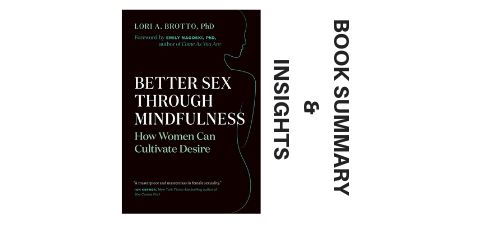Better Sex Through Mindfulness (2018) Book Summary and Insights
Book Title: Better Sex Through Mindfulness
Subtitle: How Women can Cultivate Desire
Author Name: Lori A. Brotto, PhD
Publication Date: 2018
Book Summary
This book draws focus on women’s sexuality; a topic more often shunned by society in the shadow of man’s sexuality. The author explains the link between our physical sexuality and our minds, encouraging us to be more attuned to individual sensations, down to the food we eat. Better Sex Through Mindfulness explores the cause of the ever-rising sexual problems in women and how mindfulness is the key to sexual satisfaction.
About The Author
Lori Brotto is a Canadian psychologist most notable for her interest and work in sexual arousal in women. Brotto specialises in sexual issues related to women and finding ways to help them. she has coauthored books on managing FSAD in the publication Clinical Manual of Sexual Disorders. More recently, Brotto has invested herself in the subject of mindfulness meditation in relation to sex and women health.
Who Is This Book For?
Women struggling to stay in the moment during sex
Women who experience physical or psychological pain because of sex.
Anyone who wants to improve their sex lives through mindfulness.
Buy Book: Support The Book Author And Our Work
(Don’t worry about adding anything here for now)
Great books should be read, studied, and reviewed frequently, so reading the actual book may provide more value to you than the book insights on this page. Besides, this would support the work of the book author and what we do on LarnEdu. What could be better?
Important Notes
We get a small compensation from Amazon when you visit your nearest/local Amazon site via our affiliate link to purchase an item within 24 hours or if you add it to your cart and checkout within 90 days. This is no additional cost to you and supports our work.
The information on this page is meant to supplement the actual book(it is not a book review but distils the key insights or ideas from the book in under 5000 words). The content creator or LarnEdu does not necessarily support the views, thoughts, and opinions expressed in the text/book. Reasonable skepticism should be applied with any views, thoughts or opinions expressed/shared by the book author or content creator.
Reading the contents of this page does not guarantee specific results. The best lessons are achieved from taking consistent action in the real world rather than being addicted to the illusion of progress by getting stuck on reading an infinite amount of books or book summaries and insights. LarnEdu and the content creator accepts no responsibility or liability for the accuracy of the information on this page or how it is used.
Book Insights

Introduction
Sexual dysfunction in women is a more common occurrence than you would think. Society grossly undervalues the importance of comprehensively talking about a woman’s sexual organs and what self-exploration can help women achieve.
Studies In Women Sexual Health
We consider sex to be a universally exciting, enjoyable, and empowering force but, the truth is there are many sexual difficulties men and women face.
For the enjoyment part of sex, the odds are more in the male’s favour, as multiple research has proven more women do not enjoy sex as much as their partners. Some have even gone to say sexual encounters for them are painful, intrusive, and unrewarding.
In 1999, a survey for the National Health and Life used 3,000 American men and women as its subject, asking them about their sexual lives. The research included questions on disinterest in sex, frigidity, pain during intercourse, inability to orgasm, and more. The results showed that a total 43% of the women dealt with one or more of these problems, while 31% of men had some sexual dysfunctions.
And, leading the charge in the sexual problems from the women? Almost 1/3 women reported a lack of interest in sex. 1/5 reported pain during intercourse, and the younger women’s major complaint was an inability to reach orgasm.
The United States was the area for the research with American subjects but, we find the results to be almost universal everywhere else. In Britain, results were even higher, with 51% of women complaining about sexual dysfunctions.
So, what could be the problem? And how is the problem being addressed? One would expect a more aggressive demand for sex therapy but, there is actually no change there. In fact, majority of the women would rather keep their sexual problems to themselves, even the ones experiencing discomfort. And, if they seek help at all, they usually do it through the internet and not via professionals.
One thing drives this universal silence—embarrassment to talk about sex. In fact, if most women could get past their awkwardness with all things concerning their sexual lives, they would lead a more enjoyable, mutually satisfying sex lives.
Sexual and Mental Health
A common misconception surrounding the way we view sex is that it is a purely physical act. As with everything else, our sexual experience has as much to do with our thinking as with our body.
Basically, the more mentally unhealthy you are, the less satisfying your sexual life would be. This relationship should not come as a surprise, as depressed people so often report a loss of interest in previously enjoyable hobbies such as reading and dancing.
An example of the vicious effects depression can have on a person’s sex life is Sheila, one of the author’s patients. Sheila had been living a wholesome, enjoyable sexual life until she lost her parents, her job and a friend moved away in just one year. The blows so swiftly dealt one after the other caused Sheila to sink into a pit of depression, which affected her sex life. She found that she now barely enjoyed sex, and this caused an even deeper sense of loss.
Sheila was depressed and her depression affected her sexuality but, sometimes our sex lives can be affected solely by how we think about it.
Cite Mary and Catalina here, two other patients of Dr. Brotto. Mary has shown no deep enthusiasm towards sex, and Catalina has always led an enjoyable sex life. How do these two women have such dissimilar emotions towards sex? Mary thinks sex is for reproduction only and acts on it that way, while Catalina recognises the deeper levels of intimacy sexual relations with her partner forges, and enjoys it to the fullest.
Sometimes, it is all in the mindset. The author believes that age does not have to be a factor with sex drive, saying that the women who do not believe so are less likely to suffer lower sex drives.
Stress and Sexuality
There are other ways our minds can impact our sexuality, and it’s mostly because of stress. A majority of us are stressed, having over one thought running through our minds at a time. And how do we deal with the alarming levels of stress? By multitasking. We try to cram as many tasks into a single moment, rather than taking that moment for what it is. For example, during your lunchtime, you could eat your meal, respond to emails, and make that call to your mother and so on.
It’s a huge irony we think we are achieving more, because we are cutting short on how much we give each little task, reducing our levels of efficiency.
The reason for this is that our brains were simply not built to multi-task and, when we force them to, we reduce our brain’s functionality.
When we multi-task, we also lose sight of being in the moment, most likely because of stress. Think of those nights you get home tired and irritated at your partner’s sexual advances. Or, you find your thoughts wandering towards the undone pile of laundry during a steamy bout of sex with your partner.
All these are huge sexual turnoffs and, you may think your partner does not notice, but they do. This could lead to a loss of interest or feelings of incompetence.
We need to stay more in the moment, focusing on one thing at a time, as it is important towards having a healthy sexual life.
Mindfulness
You probably have a picture of monks when you think of the word “meditation”.
The popularity of meditation today should eradicate your preconceived notions, as everyone from company executives to security personnel are now practising meditation.
Mindfulness exercises are intended to keep you solely in the present, using strategic parts of your body as an anchor, and breathing rhythms.
Here’s an example of a mindfulness exercise:
Find a comfortable position and close your eyes. Pay attention to the little things like your posture and surroundings. Focus on your breathing as it goes in and out — the feel of each breath. Notice the subtle changes from inhalation to exhalation. As you become more attuned, you may notice more the sensations that come with breathing including the speed, sound, and deepness of each breath.
Some people think it is impossible to have a totally thought-free mind and think meditation is a falsity. But in fact, the aim of meditation is not to clear your mind. A drifting mind and wandering thoughts is perfectly normal, in fact. What mindfulness therapy aims to achieve is a deeper connection of its subjects to each sensation and allowing it wash over them.
It’s difficult to make the connection between meditation, snacking on a raisin, and sex; but we’ll try it.
Dr. Brotto uses a raisin in her mindfulness therapy sessions. She hands participants raisins and encourages them to observe the size, colour, and form. Then, smell it and notice the various flavours and sensations. Next, feel it completely between your fingers, then place it on your lips and feel the sensation against your mouth. Now, place it in your mouth without biting, roll it around, and sense it. Finally, take a slow bite and savour the burst of flavour. Connect with the different tastes and stay with it as it goes down your throat.
Most women report on a startling discovery of many sensations from the raisin after the exercise. And this realisation is a complete opposite of what they get when they eat raisins the usual way—absentmindedly and without pause.
This is a direct comparison to how much heed we pay during sex. Women are often on autopilot during the events of sex, paying little attention as they would with a raisin. But, if they gave their sexual encounters the same mindfulness they did the raising with Dr. Brotto, their experience would probably be a whole new one.
Most times, all our mind needs to enjoy an experience fully is attention and complete focus.
Sexual Arousal Of The Mind And Body
We may still act prudish with matters of sexuality like sex scenes in movies but, this does not stop our bodies from reacting to the scenes. But, your mind refuses thoughts of sexual arousal. This is more normal in women than in men. This means that women’s minds are more often a step behind their bodies in terms of arousal.
Research has found men to have higher levels of connection between their bodies and minds, allowing simultaneous arousal.
Brotto has conducted research on this discord in women’s bodies and minds. A participant, Gina, reported disinterest while watching the erotic films on display, with her mind on her child’s upcoming birthday. But, her physical responses were contradictory, with a vaginal probe showing an increase in sexual arousal. Her mind was detached, but her body was aroused.
This discordance affected Gina in more ways than she knew of. She felt her body could reach orgasm as long as she was being pleasured correctly, but did not make the link between her mind and body.
Sessions with Brotto focused on helping Gina find the relation between her mind’s arousal and her body’s. Sexual response is a two-way communication involving both the brain and the body, without distractions and conflicting thoughts.
Mindfulness helps us with much more than mindful arousal; you feel more at ease with your own body during sex. The feeling of shame and awkwardness about their own bodies is common by women. Most women avoid being seen naked by their partners or being touched in areas they are insecure about.
Brotto encourages her participants to examine and explore their own bodies with mirrors, understanding the various parts of their anatomy. She encourages them to tune into their sexual arousal, allowing each sensation wash over them completely, paying attention to where the pleasure is most and how to reach it.
By exploring their bodies on their own, women have the tendency to understand better their arousal and be more confident in sexual situations.
Mindfulness and Painful Sex
We universally accept the notion that sex and pleasure go hand-in-hand. But, why then do so many women report discomfort and pain during sex?
A case study presents Savannah, a young woman in a loving relationship who was looking forward to consummation. Unfortunately, the expected moment arrived, and she experienced a huge level of pain when her boyfriend tried to penetrate her. Savannah would later come to discover she had provoked vestibulodynia (PVD); which is extreme pain upon the slightest touch of the vulva or vagina.
PVD seems like a serious situation but, we know too little about it, with little to no remedy. What research has offered is that PVD is actually cognitive, and women suffering from it relate touches to their vaginas with pain.
With mindfulness as a solution, we encourage women to pay attention to each sensation they experience, including the pain intensity, and strength. Brotto’s method follows the theory it is more effective to focus on sensations when dealing with pain than to block them. This is because the more focus you place on the physical symptoms of pain, the less emotional response you are likely to have.
The subject, Savannah, discovered reduced pain after mindfulness therapy, with a higher interest in sex.
Key Quotes
“Mindfulness-based cognitive therapy encourages patients to observe thoughts as “passing events of the mind” rather than something that needs to be attended to or believed. So often when we have a troubling thought, it leads to another one, which in turn leads to another one, and before we know it, several minutes (or hours or weeks or even months) have elapsed.”
“Sarah and the seven other women in the group were introduced to mindfulness with a simple exercise. Each woman was given a raisin, along with the following instructions from the group facilitator. 1.Observe the object. We are going to refer to this as an object, even if you recognize this and immediately know the name of it. By calling it an object, we are encouraging you to encounter this object as if for the first time. 2.Take note of its shape, size, color, and contour. 3.Notice how the light reflects off its surface. 4.Smell the object, taking in the various aromas. 5.Notice how your body responds to those aromas. 6.Lift it to your ear. 7.If you move it between your fingers, does it have a sound? There was a long pause between each instruction as the women lifted the raisin to their eyes, nose, and ears. The group facilitator continued, again with long pauses between the instructions. 8.Put the object against your lips without opening them. 9.Notice how it feels. 10.Notice if your mouth or body starts to react to having it there. The group facilitators could hear the women salivating as they anticipated putting the raisin in their mouth. 11.Now put the object in your mouth and roll it around with your tongue. Try not to bite it. What sensations do you notice? This can be a sharp example of how your mind anticipates something, and reacts physiologically to it by preparing for it. After another long pause, the facilitator continued. 12.Eventually put the object between your back teeth and slowly and deliberately take one bite. Notice the explosion of flavors. Can you decipher the different flavors? Can you observe where one flavor ends and the next one begins? 13.Then, very slowly chew into the object and follow the trajectory of its contents as they move down your esophagus. Notice the aftertaste and the echo of the aftertaste.”
“The technique known as cognitive challenging, which is a hallmark of CBT, involves challenging beliefs that may trigger anxiety or that may result from feeling chronically stressed. CBT consists of a structured set of steps in which you are first encouraged to identify beliefs or thoughts that are associated with anxiety. When you are feeling stressed or anxious, you may have a whole constellation of anxiety-related thoughts. Step 1 is to focus on one particular thought, such as “I fear that my partner will leave me unless I have a good sexual response.” In Step 2, you are asked to analyze the validity of that thought by considering such factors as whether it is true, how logical it is, and what the probability is for it to be true. In this step, you also consider the evidence supporting the thought. In Step 3, you would examine counter-evidence to the thought by asking yourself the following questions: 1.Is there another way of looking at this thought? 2.Is there another explanation? 3.How would someone else consider the same situation? 4.Are my beliefs based on my emotions rather than on facts? 5.Am I setting unrealistic or unachievable standards for myself? 6.Am I forgetting relevant facts or overemphasizing other ones? 7.Am I engaging in all-or-nothing thinking? Once you consider the evidence for the particular thought and the evidence against (with the against evidence far outweighing the for evidence in most cases), you then come up with a thought that is a more accurate reflection of reality and probabilities. This new belief will replace the original maladaptive belief you had.”
Conclusion
From the moment of reading this book, try to go about your daily life mindfully. From eating your food to having sex with your partner. Pay attention to the shape, texture and colour, and temperature of what you eat. Stay attuned to your body always, focus on how your partner touches you and the feeling the touches incite. These exercises strengthen your mindfulness and allow growth in your sexual life.
Since You’re Here…
Great books should be read, studied, and reviewed frequently, so reading the actual book may provide more value to you than the book insights on this page. Besides, this would support the work of the book author(s) and what we do on LarnEdu.
You can also support the work we do at LarnEdu work by making a one/off or monthly donation(via PayPal) for as little as £0.99 or sharing this content.
Do you have any feedback or suggestions? Use the comment section below or send us a message.















